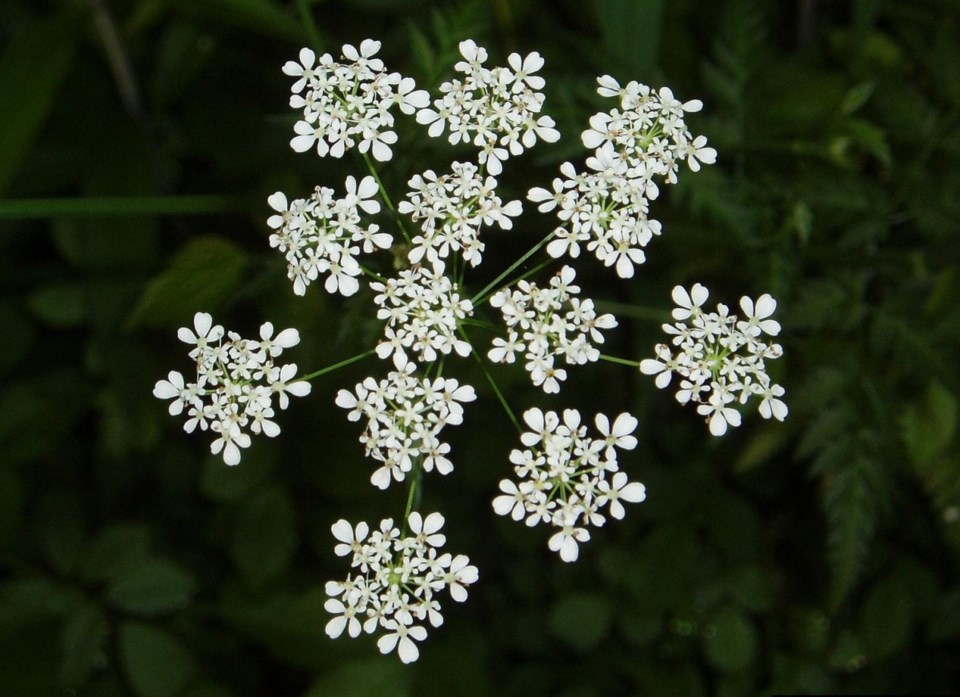NEWS RELEASE
THE TOWN OF THE BLUE MOUNTAINS
*************************
The Town of The Blue Mountains is providing this advance notice to rural residents to advise that the annual noxious weed control program to manage wild chervil will be continuing for 2020.
The pesticide application will be conducted by a licensed technician and only applied to grass roadside areas that appear to be visually unkept and where there is evidence of noxious weeds. In addition, a map has been included in this notice to help identify the approximate areas where the pesticide will be sprayed.
The noxious weed control program is regulated under the Weed Control Act and is used to control and eradicate wild chervil, which is deemed as a noxious weed in the Province of Ontario. The spraying will occur over four consecutive days, between the middle of May to early June, depending upon the weather, and the town will issue a formal notice on the newsroom of the town website before the spraying starts.
Opt-out of Pesticide Spraying and Do Not Spray Signs
To opt-out of pesticide spraying on the road allowance fronting a property, residents should contact the town to receive a ‘Do Not Spray’ sign that can be installed on the road allowance at the limits of the property’s frontage. In addition, the contractors have been advised to only apply the pesticide to grass roadside areas that appear to be visually unkept and where there is evidence of wild chervil.
It is important to note that under the provincial Weed Control Act, the town is required to control wild chervil. Regardless of posted signs, unmaintained sections of the town road allowance will still be sprayed if there is evidence of wild chervil.
If you have questions about this process or would like to request a sign, please call 519-599- 3131 ext. 276. If you live along a County Road, please direct your inquires or questions to 519- 376-7337 or via email at [email protected].
Proactive Monitoring & Cooperative Compliance
The town remains committed to ensuring that the spread of Wild Chervil is managed and controlled. To that end, the town recently appointed an additional weed inspector who will be trained on wild chervil identification and who will be available to assist residents. Enforcement of the town’s noxious weed bylaw continues to place emphasis on education and cooperative compliance. In addition, town staff will be monitoring wild chervil throughout the season in an effort to assess the effectiveness of control and reducing spread.
Shared Stewardship
Wild chervil is detrimental to agricultural lands. The town encourages all property owners and residents to actively identify and eliminate wild chervil on their own properties in fields, lawns and gardens to help reduce the spread of this noxious weed. To assist with identification and elimination options, please visit the following wild chervil FAQ page on the town website: https://www.thebluemountains.ca/roads-drainage.cfm
Additional Information on wild chervil can be found by visiting the Ontario Invading Species Awareness Program website: http://www.invadingspecies.com/wild-chervil/
It is also important to understand that wild chervil can be confused with Queen Anne’s lace (Daucus carota). However, the leaves of wild chervil are more distinctively fernlike in shape. The umbels of Queen Anne’s lace have bracts below them, while the umbels of wild chervil do not have bracts. Wild chervil usually flowers in mid- to late spring; Queen Anne’s lace flowers later in the season. https://cisma-suasco.org/invasive/wild-chervil/
Road Jurisdiction
It is also important to understand that the Town of The Blue Mountains will only be spraying rural roads that are within the jurisdiction of the Town of Blue Mountains.
All county roads are within the jurisdiction of County of Grey, which administers their own noxious weed control program. For information, please visit: www.grey.ca
What is Wild Chervil?
Wild chervil is a herbaceous biennial or short-lived perennial from the parsley family, introduced to North America from Europe. It was first brought to North America as part of European wildflower seed mix used for plantings along hedgerows and meadows.
This species is short-lived, forming a rosette of only leaves in the first year, then flowering and producing seeds in the second year. As a heavy seed producer, it is easily spread to new locations. Wild chervil has few checks on its population in North America and can quickly take over an area, displacing native species and forming dense stands that are difficult to control.
Source: Ontario’s Invading Species Awareness Program
What Chemical is Being Sprayed?
The licensed contractor will be using Truvist Herbicide, which contains the active ingredients, Chlorsulfuron and Aminocyclopyrachlor. PCP Registration Number 30920 in combination with Hasten NT Spray Adjuvant, which contains active ingredients Methyl and ethyl oleate (esterified vegetable oil). PCP Registration Number 28277 under the Pest Control Products Act. Truvist is an approved herbicide shown to be effective in controlling wild chervil along the town road allowance.
To learn more or to view a detailed FAQ regarding the noxious weed control program, please visit: www.thebluemountains.ca/roads-drainage.cfm
*************************



